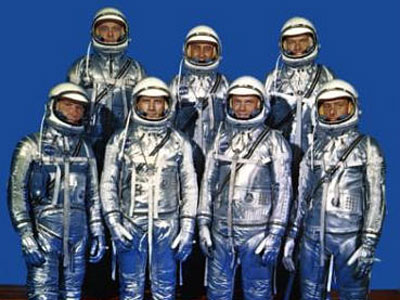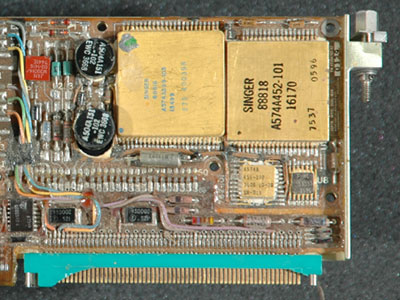
Spaceships portrayed in the movies have vastly complicated computers running them. Databanks brimming over with the sum knowledge of human (or alien) kind within them. But as we know, life rarely imitates art, and none so more the case as real-life space computing.
Why is it, that at a time where you can go and buy a machine that is several thousands of times more powerful than the sum computing capability of NASA at the time of the Apollo moon shots, does the space industry lob hardware up there that’s only marginally faster than an old 386? Let’s find out. And no, before you ask, it’s not to stop infiltration by attractive looking clones and walking toasters.
The first thing to realise is that spacecraft don’t really need to be very clever at all. A rocket on the pad has one goal – up. And to keep a rocket going up doesn’t require billions of calculations per second. It does require a colossal amount of grunt from the engines, but the guidance system just needs to be able to keep your giant firework on a relatively accurate course – once in orbit, your course can be corrected and finessed with ease. And all of this can be done with a tiny amount of computational power.
Or no power at all, in the case of the early days of rocketry – the V2 just relied on accelerometers to gauge if it had hit the correct speed for it’s sub – orbital lob toward London. Besides, it’s much more important to be hyper-reliable in the calculations, not hyper-quick. Computers need to be able to withstand the enormous G and acceleration of takeoff, and function flawlessly during ascent. And the easiest way to do that is to keep it simple, and relatively dumb – so much so that the latest Ariane or Titan probably has less power than your Nintendo DS. A lot less.
Once you’re up there, the tasks that need to be accomplished may change, but the power requirements aren’t so different. Just making left turns around the planet isn’t the most difficult thing to calculate. The first manned space flight had a computer on board to control re-entry, but it was basic in the extreme – and locked so Comrade Gagarin couldn’t tamper with it. An envelope with the code to unlock the computer was hidden somewhere in the capsule, and should an emergency arise, ground control would tell him where it was. Nice.
The first Americans in space didn’t even have luxury of locked computers – The Mercury 7 astronauts where riding around in tin cans that had no on board computers at all – they relied on radioed instructions to the craft to start re-entry – as all of the computing was being done back at mission control.

"Gee, I wish I knew where the unlock code was..."

"Gee, we wish we had a computer to unlock!"
But that was back in the heady days of the space race. What of today?
Well, the calculations that need to be done to get into space and stay there haven’t changed over the intervening decades, but the computers have. But only marginally.
Take the Space Shuttle, which is due to resume flight operations after a two-year break after the Columbia disaster. It must have some beefy hardware onboard, right?
Hmmm. Don’t get me wrong; the Orbiter has state of the art computing technology aboard - state of the art for the late 70’s early 80’s that is. It’s run by four parallel redundant AP-101S general purpose computers supplied by Big Blue, with a fifth as an independent back up. Sounds impressive, but only in the fact that they’re sturdy beasts of silicon burden, rather than exotic thorough-breds.

Part of an AP101S. Has that homebrew feeling, eh?

Shuttle Memory - Not available from Corsair
So why hasn’t it been upgraded during the years? Easy – they haven’t needed to. It’s proven technology that’s shown itself to be resilient to the rigours of spaceflight.
Even the International Space Station has less brains than you would think. Obviously the hardware is more modern than that of the Shuttle – after all, it’s a lot newer for a start. It stays up there thanks to the phenomenal computing power of - wait for it….
An 80-386SX CPU
Can you feel the speed?
That doesn’t mean to say the Shuttle or the ISS flies without more up to date (read: fast) computers – they do. It's just in the form of the modern Laptops taken up by the astronauts, rather than integrated spacecraft systems.
But surely newer CPUs can do the job as well? Well yes, they can. But other problems arise from using newer hardware in space. For one thing, newer processors (for the most part) guzzle energy – something that your average spacecraft doesn’t have a lot of. Whilst the Enterprise and it’s film counterparts have exotic power sources to help drive them through space and power their systems, real spacecraft have to make do with fuel cells, solar panels, and, if you’re going deepspace (by that I mean the outer planets where the sun isn't strong enough for solar power), Radioisotope Thermal Generators (RTGs).
But all these power sources have one thing in common – they don’t put out a lot of juice. So the less power your computer system draws, the better. Which invariably means slower.
Why is it, that at a time where you can go and buy a machine that is several thousands of times more powerful than the sum computing capability of NASA at the time of the Apollo moon shots, does the space industry lob hardware up there that’s only marginally faster than an old 386? Let’s find out. And no, before you ask, it’s not to stop infiltration by attractive looking clones and walking toasters.
The first thing to realise is that spacecraft don’t really need to be very clever at all. A rocket on the pad has one goal – up. And to keep a rocket going up doesn’t require billions of calculations per second. It does require a colossal amount of grunt from the engines, but the guidance system just needs to be able to keep your giant firework on a relatively accurate course – once in orbit, your course can be corrected and finessed with ease. And all of this can be done with a tiny amount of computational power.
Or no power at all, in the case of the early days of rocketry – the V2 just relied on accelerometers to gauge if it had hit the correct speed for it’s sub – orbital lob toward London. Besides, it’s much more important to be hyper-reliable in the calculations, not hyper-quick. Computers need to be able to withstand the enormous G and acceleration of takeoff, and function flawlessly during ascent. And the easiest way to do that is to keep it simple, and relatively dumb – so much so that the latest Ariane or Titan probably has less power than your Nintendo DS. A lot less.
Once you’re up there, the tasks that need to be accomplished may change, but the power requirements aren’t so different. Just making left turns around the planet isn’t the most difficult thing to calculate. The first manned space flight had a computer on board to control re-entry, but it was basic in the extreme – and locked so Comrade Gagarin couldn’t tamper with it. An envelope with the code to unlock the computer was hidden somewhere in the capsule, and should an emergency arise, ground control would tell him where it was. Nice.
The first Americans in space didn’t even have luxury of locked computers – The Mercury 7 astronauts where riding around in tin cans that had no on board computers at all – they relied on radioed instructions to the craft to start re-entry – as all of the computing was being done back at mission control.

"Gee, I wish I knew where the unlock code was..."

"Gee, we wish we had a computer to unlock!"
But that was back in the heady days of the space race. What of today?
Well, the calculations that need to be done to get into space and stay there haven’t changed over the intervening decades, but the computers have. But only marginally.
Take the Space Shuttle, which is due to resume flight operations after a two-year break after the Columbia disaster. It must have some beefy hardware onboard, right?
Hmmm. Don’t get me wrong; the Orbiter has state of the art computing technology aboard - state of the art for the late 70’s early 80’s that is. It’s run by four parallel redundant AP-101S general purpose computers supplied by Big Blue, with a fifth as an independent back up. Sounds impressive, but only in the fact that they’re sturdy beasts of silicon burden, rather than exotic thorough-breds.

Part of an AP101S. Has that homebrew feeling, eh?

Shuttle Memory - Not available from Corsair
So why hasn’t it been upgraded during the years? Easy – they haven’t needed to. It’s proven technology that’s shown itself to be resilient to the rigours of spaceflight.
Even the International Space Station has less brains than you would think. Obviously the hardware is more modern than that of the Shuttle – after all, it’s a lot newer for a start. It stays up there thanks to the phenomenal computing power of - wait for it….
An 80-386SX CPU
Can you feel the speed?
That doesn’t mean to say the Shuttle or the ISS flies without more up to date (read: fast) computers – they do. It's just in the form of the modern Laptops taken up by the astronauts, rather than integrated spacecraft systems.
But surely newer CPUs can do the job as well? Well yes, they can. But other problems arise from using newer hardware in space. For one thing, newer processors (for the most part) guzzle energy – something that your average spacecraft doesn’t have a lot of. Whilst the Enterprise and it’s film counterparts have exotic power sources to help drive them through space and power their systems, real spacecraft have to make do with fuel cells, solar panels, and, if you’re going deepspace (by that I mean the outer planets where the sun isn't strong enough for solar power), Radioisotope Thermal Generators (RTGs).
But all these power sources have one thing in common – they don’t put out a lot of juice. So the less power your computer system draws, the better. Which invariably means slower.

MSI MPG Velox 100R Chassis Review
October 14 2021 | 15:04






Want to comment? Please log in.